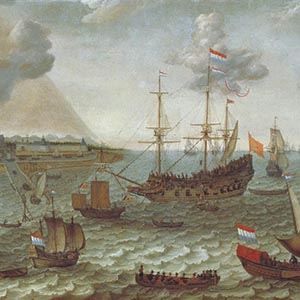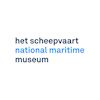
05. Noord 0, Republic at Sea: The roadstead of Batavia
This painting shows the anchoring place of ships in Batavia (modern-day Jakarta in Indonesia) during the mid-seventeenth century. The Dutch East India Company – known at home as ‘the VOC’ (an abbreviation of its Dutch name,) founded a settlement here in 1619, after destroying the Javan city of Jacatra – to serve as the hub of its Asian trading network. Goods were brought here from all over Asia by various ocean routes and were then sent to the Republic three times a year with the returning fleet. On the left-hand side of the painting, we can see the access to the port, the fortified walls and a Dutch church in the background. At the centre of the canvas, a large VOC merchant navy vessel is at anchor. The painter had never visited Batavia himself, which we can tell, for example, from the small Chinese junks, also on the left-hand side of the painting, that are not portrayed realistically. The painting’s primary aim was to give prominence to the large ship at the centre, known as an East Indiaman. Batavia developed into a multicultural society of not only Javanese but also numerous Chinese, Balinese and Ambonese inhabitants. There was a great deal of trade which, combined with the enslavement of many Asians by the Dutch, resulted in economic growth and a flourishing city.


The National Maritime Museum
Het Scheepvaartmuseum (The National Maritime Museum) shows the strong connection between the maritime world and society as a whole, and more specifically the impact of this on the lives of many individuals. The collection of The National Maritime Museum is one of the largest and most notable maritime collections in the world with approximately 400,000 objects, including paintings, models of ships, navigation instruments, and maps of the world. Discover 500 years of Dutch Maritime history as well as its strong links to today’s society and the society of the future.
- Kattenburgerplein 1
- Amsterdam Netherlands
- (020) 52 32 222
- www.hetscheepvaartmuseum.nl
